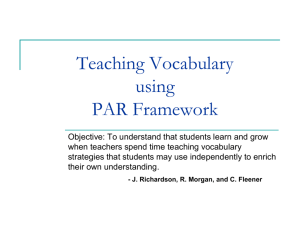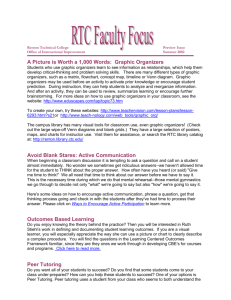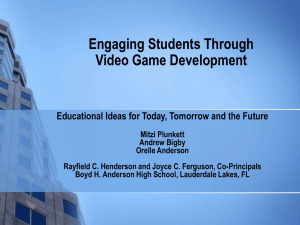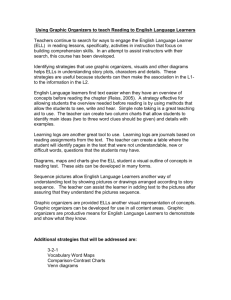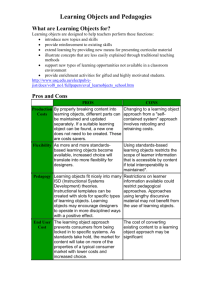LCI Strategies
advertisement
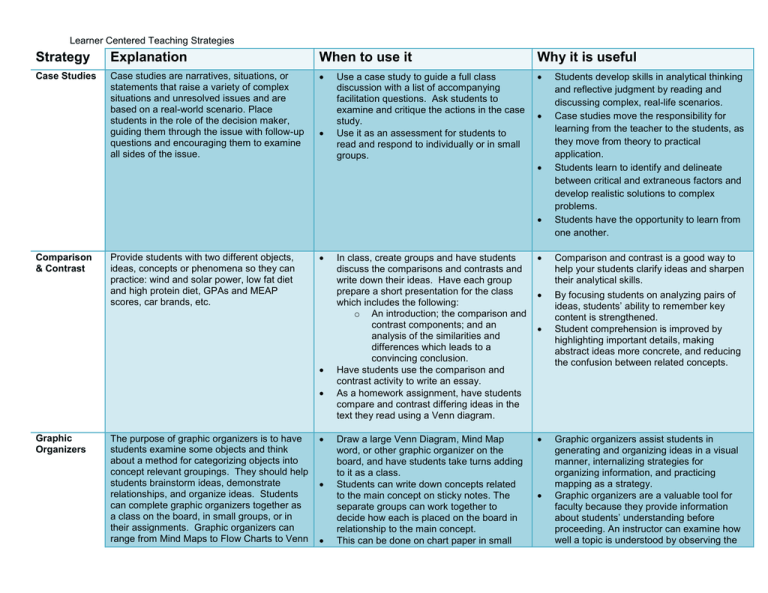
Learner Centered Teaching Strategies Strategy Explanation When to use it Why it is useful Case Studies Case studies are narratives, situations, or statements that raise a variety of complex situations and unresolved issues and are based on a real-world scenario. Place students in the role of the decision maker, guiding them through the issue with follow-up questions and encouraging them to examine all sides of the issue. Use a case study to guide a full class discussion with a list of accompanying facilitation questions. Ask students to examine and critique the actions in the case study. Use it as an assessment for students to read and respond to individually or in small groups. Comparison & Contrast Provide students with two different objects, ideas, concepts or phenomena so they can practice: wind and solar power, low fat diet and high protein diet, GPAs and MEAP scores, car brands, etc. Graphic Organizers The purpose of graphic organizers is to have students examine some objects and think about a method for categorizing objects into concept relevant groupings. They should help students brainstorm ideas, demonstrate relationships, and organize ideas. Students can complete graphic organizers together as a class on the board, in small groups, or in their assignments. Graphic organizers can range from Mind Maps to Flow Charts to Venn Students develop skills in analytical thinking and reflective judgment by reading and discussing complex, real-life scenarios. Case studies move the responsibility for learning from the teacher to the students, as they move from theory to practical application. Students learn to identify and delineate between critical and extraneous factors and develop realistic solutions to complex problems. Students have the opportunity to learn from one another. In class, create groups and have students discuss the comparisons and contrasts and write down their ideas. Have each group prepare a short presentation for the class which includes the following: o An introduction; the comparison and contrast components; and an analysis of the similarities and differences which leads to a convincing conclusion. Have students use the comparison and contrast activity to write an essay. As a homework assignment, have students compare and contrast differing ideas in the text they read using a Venn diagram. Comparison and contrast is a good way to help your students clarify ideas and sharpen their analytical skills. By focusing students on analyzing pairs of ideas, students’ ability to remember key content is strengthened. Student comprehension is improved by highlighting important details, making abstract ideas more concrete, and reducing the confusion between related concepts. Draw a large Venn Diagram, Mind Map word, or other graphic organizer on the board, and have students take turns adding to it as a class. Students can write down concepts related to the main concept on sticky notes. The separate groups can work together to decide how each is placed on the board in relationship to the main concept. This can be done on chart paper in small Graphic organizers assist students in generating and organizing ideas in a visual manner, internalizing strategies for organizing information, and practicing mapping as a strategy. Graphic organizers are a valuable tool for faculty because they provide information about students’ understanding before proceeding. An instructor can examine how well a topic is understood by observing the Learner Centered Teaching Strategies Diagrams. Encourage students to use different colors to emphasize the visual aspects. Fishbowl A small group of students should sit in a circle in the center of class where they will demonstrate a discussion on a topic. The discussion should be educated, in-depth, and prepared somewhat beforehand. The rest of the class should sit around them and watch, taking notes on what the group does well or could be improved upon. groups. Have groups post papers around the room and have everyone look at other groups’ work and add additional ideas. Inspiration Software, Inc. – Visual learning tool that inspires students to develop and organize their ideasmapping software http://www.inspiration.com/ Take turns with groups completing this activity in class. This could also be conducted online in the Discussion Board, with all groups performing simultaneously. Jigsaw This is an efficient strategy for helping students master different pieces of information and then immediately teach it to others to reinforce learning. Break students into their first round of groups, where students will review a segment of the material and prepare how to teach the material to their second group. Then, break students into their second groups, which consist of all new group members. Students take turns teaching what they learned in the first group with the group members of their second group. Complete in class together with students broken into groups. This will require some planning ahead in order to make sure groups are organized properly. sophistication and depth of the graphic organizer. This teaching strategy is a process in which students learn to sort specific experiences into general rules or classes providing them with the opportunity to explore ideas by making connections and seeing relationships between or among items or ideas. Provides structure for in-depth discussion and provides an opportunity for students to model or observe group processes in a discussion setting. This teaching strategy helps students practice being both contributors and listeners in a discussion. This strategy is especially useful when you want to make sure all students participate in the discussion; when you want to help students reflect on what a “good discussion” looks like; when you want students to consider a variety of perspectives or viewpoints; when you want students to walk through a process together; and when you need a structure for discussing controversial or difficult topics. Fishbowls allow the instructor to see what misconceptions students have and to address them. Helps participants master different pieces of information that, when put together, cover a complete topic. Students soon realize that each piece--each student's part--is essential for full understanding of the material. Experienced teachers know that teaching something to others requires an understanding of the subject matter beyond surface learning. As students develop strategies for teaching to their peers, they may discover examples, anecdotes, or analogies that enhance their comprehension. The jigsaw approach can provide a pleasant alternative to lecture for helping students learn conceptual material. Learner Centered Teaching Strategies One-Minute A one-minute paper is normally completed at Paper the end of a class session. Ask students a few review questions at the end of a lesson, such as: What was the most important point made in class today? What unanswered question(s) do you still have? How does/will _______ relate to your future profession? What can you tell me about _______? At the end of each class session. Ask students to name five significant points that have been made in class that day. Provides you with timely feedback about what your students have learned or what questions are still unanswered. Reinforces learning for students, assists in developing students’ critical thinking skills, and tells you something about your own teaching. Students know you are paying attention to them and to their needs if you begin the next class by clarifying where necessary. Allow students 1-2 minutes to respond, collect the responses and discuss the common themes before the next lesson. Pairs Check Allows students to review work with a peer and provides an opportunity for students to communicate their thinking to students. Have pairs work on a problem together, while students take turns solving the problem and coaching each other. Silent Socratic Dialog Silent Socratic Dialog is a silent form of inquiry and debate between individuals with opposing viewpoints based on writing responses and answering questions to stimulate critical thinking to clarify ideas. Ask students to pair up and explain that there will be no talking, only written communication. Students will individually respond to an openended question, and then swap responses. They will write a question in reference to their partner’s response and swap back. Students will read this new question and respond. Students should continue this swapping/question/answer process two more times before writing a final thought on their partners’ papers. Have students do exercises individually before class. One student explains his/her answer on a question to another student, and they discuss it. Then, they reverse roles for the next question. Answers are agreed upon before sharing with the whole team. Teammates help each other understand answers to exercises so that any member of the team may be called upon to answer any one of the questions. This activity can be used as a guideline for classroom discussion, or Socratic dialogue, in which the instructor provides a wellformulated question that requires personal responses from students. These responses elicit further questions and so on. This can be used at the beginning of lesson to get students thinking about the topic, or at the end to help them synthesize the new information. It is a good way for shyer or more reticent students, in particular, to take the time to express their thoughts and questions. It is low risk for shy or passive students or students who may lack confidence. It gives students the opportunity to verbalize their thought processes while explaining the steps. It allows students to learn from one another. Promotes thoughtful questioning. Students must have an understanding of their partners’ responses to write a relevant, thought-provoking question. Allows students who are not comfortable speaking up in class to share their thoughts, opinions, etc., via silent discussion. Promotes individual accountability – Each student must participate in discussion with his/her partner. Requires potentially deeper understanding as writing may provide an opportunity for a more in-depth thought process than speaking. Learner Centered Teaching Strategies Think Write This is a good way for you and your students Pair Share to verify what has been learned by comparing lecture notes, doing a quiz review, checking for comprehension on reading assignments, and responding to discussion questions. Give students a couple of minutes to reflect and write a response to the question or problem posed. Have each student pair with another student to compare/contrast answers. If the answers are not in agreement, have students explain to each other how they reached their answers, and decide on a mutual response. Ask a few students to share their own answers, their partners’ answers, or the discussion they had with each other. Pro/Con Grid Students’ Pro/Con Grids provide the instructor with an overview of the depth and breadth of students’ knowledge and demonstrate students’ ability to analyze data. Select a debatable topic or issue that relates to the Student Learning Outcomes and have students create a pros and cons list. Guide students by providing a prompt that will act as a trigger, and indicate a specific view point that should be adopted. Students practice their new skills and apply them to a real-world scenario that pertains to the course content. When completing these in class, provide students with the setting and what needs to be accomplished in the scenario, for example: Demonstrating professional or ethical behavior. Practice interviewing or engaging with customers/clients/coworkers. Application of knowledge to a workplace scenario, i.e. simulated surgery for a surgical technologist. Role Plays and Simulations Use at the end of the lesson to review what was covered that day. Use at the end of the week to review the topics for the week. Use before an exam to review content. A shorter version of this - Think/Pair/Share (minus the individual writing) can be used if time is limited. Students can complete this activity in class, or as a homework assignment. Can complete in groups or individually. Select a perspective or role and ask your students to do a pro/con list for both sides of the issue. Have students take opposing sides for pro/cons. Once lists have been made, have students switch sides and defend the opposite viewpoint. List pros and cons briefly and quickly; later, after the Pro and Con Grid has been assessed and feedback given, ask students to their statements with evidence and analysis. This can function as a learning experience or as an assessment, but should be conducted in class. Students can practice in pairs or small groups and critique each other. Students can perform in a more formal setting in front of the class as a presentation of their skills. Allows students time to formulate an opinion on a topic and then share it with another student before sharing with the entire class. Class size is not an obstacle because this activity can be used with any size class to get students involved with the material. Activity is a good “warm-up” to use during earlier class sessions if you plan to increase class discussions as the term progresses. Even if their answers/responses are incorrect, students are still learning as they discuss the problems with a partner and come up with the correct responses. This type of activity helps students develop the ability to weigh competing factors and forces them to look at both sides of an argument or position even when their own beliefs might be set on one side of an issue. This activity provides an excellent way to introduce a controversial issue connected with your course material as students are required to look at both sides of an issue. Allows students the chance to practice necessary skills, and apply the 21st Century skills they should be learning for their career. Accomplishes application requirements for Student Learning Outcomes. Learner Centered Teaching Strategies Depending on the setting and content, make sure to provide students with detailed guidelines of what they should be accomplishing in each role play or simulation. Presentations Students present on a topic to the class to illustrate their knowledge and learning. The presentation gives the student an opportunity to relay or teach their knowledge to the class, while also practicing their public teaching skills. Presentations can be informal where students simply stand at their desk to report on an article or chapter, or they can be more formal where students will need to dress professionally and include visuals, PowerPoint, etc. Can be a formal presentation towards the end of the course as a part of a cumulative assessment. Can be informal presentations throughout the course on various topics, in groups or individually, to help students practice presenting. This gives students important practice speaking in front of their peers and presenting to a crowd. This is an important skill to develop for many future careers. Presenting in groups and individually and presenting formally and informally gives students a wide range of practice in presenting in different settings, and helps them to become more comfortable presenting overall.
